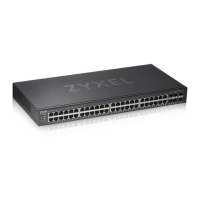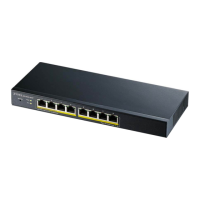Chapter 29 Error Disable
GS1920 Series User’s Guide
242
29.4 CPU Protection Configuration
Switches exchange protocol control packets in a network to get the latest networking information.
If a switch receives large numbers of control packets, such as ARP, BPDU or IGMP packets, which
are to be processed by the CPU, the CPU may become overloaded and be unable to handle regular
tasks properly.
The CPU protection feature allows you to limit the rate of ARP, BPDU and IGMP packets to be
delivered to the CPU on a port. This enhances the CPU efficiency and protects against potential DoS
attacks or errors from other network(s). Then, you can choose to drop or bypass the control
packets, decrease the priority value to CPU of control packets that exceed the specified rate limit or
disable a port on which the packets are received.
Use this screen to limit the maximum number of control packets (ARP, BPDU and/or IGMP) that the
Switch can receive or transmit on a port. Click the Click Here link next to CPU protection in the
Advanced Application > Errdisable screen to display the screen as shown.
Note: After you configure this screen, make sure you also enable error detection for the
specific control packets in the Advanced Application > Errdisable > Errdisable
Detect screen.
Figure 177 Advanced Application > Errdisable > CPU protection
Status This field displays the errdisable status
• Forwarding: The Switch is forwarding packets. Rate-limitation mode is always in
Forwarding status.
• Err-disable: The Switch disables the port on which the control packets are received
(inactive-port) or drops specified control packets on the port (inactive-reason)
Recovery
Time
This field displays the time (seconds) left before the port(s) becomes active of Errdisable
Recovery.
Total
Dropped
This field displays the total packet number dropped by this port where the packet rate
exceeds the rate of mode rate-limitation.
Table 113 Advanced Application > Errdisable > Errdisable Status (continued)
LABEL DESCRIPTION

